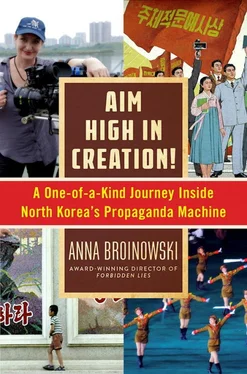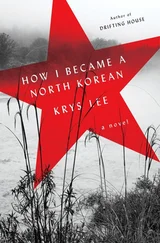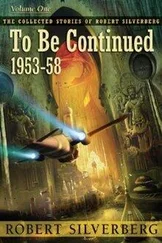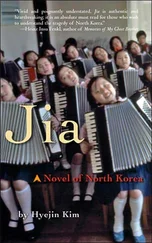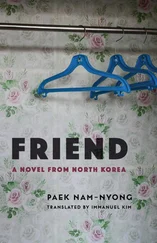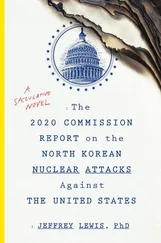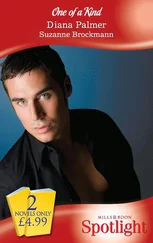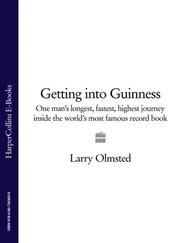I arrive at the head of a long corridor with thick crimson carpet and a mirrored ceiling—it could be the set from The Shining . Smooth grey doors run down both sides at perfect intervals. Above each one is a number in a slanted, seventies sci-fi font. The place is dead quiet. I tiptoe down the carpet and press my ear to a door. All I can hear is the faint hum of air-conditioning, and somewhere beyond that, the muffled creaks of the Yangakkdo’s metal skin, expanding in the heat. Suddenly, a door at the end of the corridor opens. There’s a hot gust of air and a sound I recognise: the loud hum of industrial fans—the kind that TV tape rooms use to stop monitors overheating.
Before I can peer inside, the door shuts. A young man in a crisp white shirt and thick glasses walks towards me. He stops. “You are lost,” he says matter-of-factly, in the clipped accent I’m coming to know so well.
“Not really.” I smile. “I was just wondering if this is some kind of film equipment place?”
He nods benignly, as if guests ask him this every day: “The business centre is on the ground floor.”
I jiggle the handle of one of the locked doors: “Maybe you can help me? I just want to see.”
He watches politely as I try one door after another. I suddenly feel embarrassed: what if there is nothing behind the doors but hotel rooms? That would make me a stalker—or worse, a thief. I stop and give him an apologetic smile. He doesn’t smile back and points at the stairs: “The business centre is on the ground floor.”
I’m eyeballing Simon Sheen again, back where I started. He gives me a jaded blink: What did you expect? I decide to cut my losses and film the lobby. No one seems bothered by my camera down here; the bellboys move their mop buckets so I can line up a shot of the revolving doors, and the lady in the bookshop smiles as I snap off rows of Kim Jong Il instruction manuals, on everything from ostrich farming to ikebana. I ask if she sells Dear Leader pins, and she waves her hand frantically in front of her face, as if I’ve just asked for a crucifix in a mosque: “No, no, not possible!” Clearly, capitalist infidels are not allowed to wear the pins—they are holy objects, not souvenirs. I apologise, feeling like an idiot for asking. She nods kindly and pulls out a tray of Juche Tower badges. They are much tackier than the Dear Leader pins, and wonderfully kitsch.
I buy some badges for my actors, along with the new Kim Jong Il biography A Great Personality , a sombre tome called Japan’s War Crimes , and a brightly coloured cookbook, Best Recipes of Pyongyang . The recipes are too fascinating, both gastrically and economically, to pass up. “Aspic jelly of ox trotter,” the Cook’s Association of the DPRK assures me, is one of the “speciality foods of Pyongyang where the immemorial history and brilliant culture are prouding themselves.” The picture displays a congealed, translucent meatloaf. Made from ox feet, tongues, tendons, and tails, “aspic jelly of ox trotter” requires the diligent Pyongyang housewife to “cook slowly, skimming fat and scums until the meats become tender” before seasoning the whole thing with salt to release its “nutritive value, good taste, and various medical properties.”
Quietly thankful I didn’t eat breakfast, I wander off to explore the banquet halls. They are huge, clean, and empty. Banquet Hall Number One has a mural of snowy mountain peaks that I recognize from the happy snap Kim Jong Il took with Madeleine Albright when she visited in 2000. On her last day, she gave him a basketball signed by Michael Jordan and wore a gold brooch of the earth—which the North Koreans interpreted as a hopeful sign that the Americans wanted peace. The Albright basketball now sits on a velvet cushion in the International Friendship Exhibition, alongside gifts from Gaddafi, Arafat, Castro, Ceausescu, Mao, and Stalin. There’s a bear’s head from Romania, a crocodile suitcase from Cuba, a gem-encrusted sword from Palestine, an armoured train carriage from China, an East German tank, and a bulletproof Soviet limousine.
I am sure the bellboys polishing the floors outside Banquet Hall Number One have been to the International Friendship Exhibition many times: North Korea is full of museums, which children visit from kindergarten onwards to learn about the outside world. The propaganda displayed in the Three Revolutions Exhibition, the Victorious Fatherland Liberation War Museum, and the Museum of American War Atrocities is reinforced by KCNA, the state-run TV channel, and the “walled garden” of the North Korean intranet, which blocks the World Wide Web. If I were an ordinary person raised in Pyongyang, my understanding of the world might go something like this:
Kim Il Sung saved us from the imperialist Japanese in 1945. Before that, we were horribly oppressed by feudal overlords. Then, in 1950, the Americans invaded and tried to oppress us all over again. They killed 2.5 million Koreans, subjugating us to their corrupt capitalist ideology. But Kim Il Sung and his guerrilla fighters fought back valiantly and drove them out.
Our cousins in the South were not so lucky: they fell under the spell of materialist greed and became the lackeys of America. As a result, they live in abject poverty, and our nation is tragically divided. Thanks to our superior socialist system, we live purposeful, hard-working lives. But our hearts are filled with bitter grief at the families and friends lost over the border. We wait for the day when we can liberate them, and share the joys of Juche.
The Americans are sore losers who can’t admit they lost the war. Every year they threaten to attack us again. If our Dear Leader hadn’t built nuclear rockets to make us a global superpower, America would invade and destroy us, just like it has invaded sixty-nine sovereign nations since 1776. The Yankees are toxic warmongers, and we are the only people in the world not to bend to their will. Every July 4 is “Independence from America” day.
As for the Westerners who come here, with their shiny gadgets and unkempt clothes, they too will one day see the light. The way they look at us, with condescending pity, is irritating. But we know we have nothing to envy. Capitalism creates masses of illiterate poor who are mercilessly exploited by the obscenely rich few.
We do not ask the Westerners any questions. People who have done so have disappeared. So we just smile politely and treat them as our guests.
The waitress in Restaurant Number Two smiles on cue when I walk in with my camera. Restaurant Number Two is identical to Restaurant Number One in every detail: white and square, with a pretty woman in a pink hanbok to take your order. The hanbok is a traditional Korean gown shaped like a parachute. The floor-length skirt creates the illusion that the wearer is floating. The waitress glides towards me like a North Korean hovercraft and asks what I’d like for breakfast. I say I’d like a photo of her to show my daughter, and she sweetly obliges.
I walk next door. The Korean Barbeque Restaurant is hidden behind a fortress-like gate with antique iron hinges. The gleaming photos of bulgogi and bibimbap look appealing—but the door is locked. I try the glass exit door, leading out to a vast courtyard. The view of Pyongyang, spread across the river at the bottom of the steps, is spectacular, but the door, again, is locked. The Yangakkdo’s guests may already be marooned on an island, but clearly, if we want to explore the gardens, we must exit through the lobby. I guess that’s so the bellboys can ensure a minder comes too. I jiggle the rusting padlock, hoping to get a closer look at the smoke gushing from a pipe to the west of the city. The smoke has smothered the buildings in a thick white haze. Perhaps Pyongyang’s air is not so clean after all, but I won’t be able to smell it to know for sure: the lock doesn’t budge.
Читать дальше
